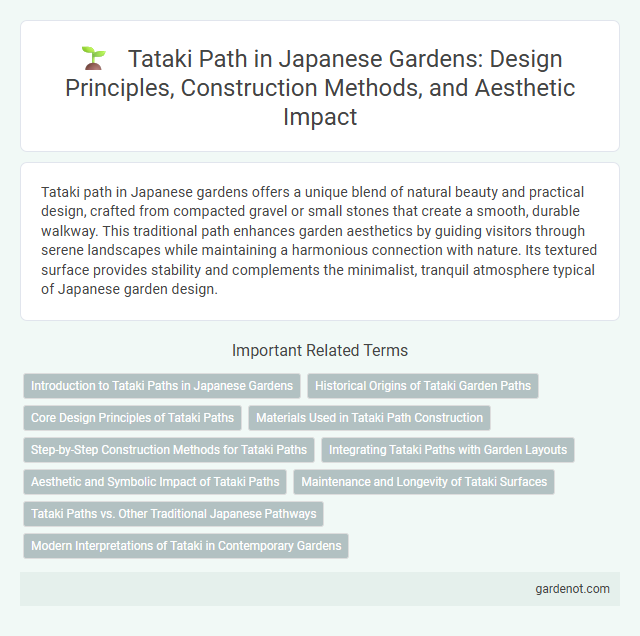Tataki path in Japanese gardens offers a unique blend of natural beauty and practical design, crafted from compacted gravel or small stones that create a smooth, durable walkway. This traditional path enhances garden aesthetics by guiding visitors through serene landscapes while maintaining a harmonious connection with nature. Its textured surface provides stability and complements the minimalist, tranquil atmosphere typical of Japanese garden design.
Introduction to Tataki Paths in Japanese Gardens
Tataki paths in Japanese gardens are traditional walkways crafted from compacted earth or gravel, providing a natural, rustic texture that complements the serene landscape. These paths enhance the garden's aesthetic by guiding visitors through carefully curated views, blending functionality with minimalist design. Incorporating tataki paths emphasizes harmony with nature, a core principle in Japanese garden architecture.
Historical Origins of Tataki Garden Paths
Tataki garden paths originate from ancient Japanese landscaping techniques that date back to the Edo period, characterized by their unique crushed stone surfaces compacted to create durable walkways. These paths were initially designed to guide visitors through traditional Zen gardens, emphasizing simplicity and natural aesthetics in alignment with Japanese cultural values. The textured surface not only serves functional needs for traction but also symbolizes a harmonious blend between human craftsmanship and nature.
Core Design Principles of Tataki Paths
Tataki paths in Japanese gardens embody simplicity and natural harmony by using compacted gravel or earth to create smooth, durable walkways that blend seamlessly with the surrounding landscape. Their core design principles emphasize organic shapes, irregular patterns, and subtle color variations to reflect natural aesthetics while guiding visitors gently through the garden. These paths promote a tactile, grounded experience, encouraging mindfulness and connection to nature with every step.
Materials Used in Tataki Path Construction
Tataki Path construction utilizes traditional materials such as finely crushed stone, earth, and natural aggregates mixed with lime or clay to create a firm, porous surface. The layer is compacted meticulously to ensure durability and proper drainage, preserving the garden's aesthetic and functional harmony. This blend of organic materials reflects the craftsmanship and sustainable principles integral to Japanese garden design.
Step-by-Step Construction Methods for Tataki Paths
Tataki paths in Japanese gardens are constructed by compacting a mixture of crushed stone, clay, and water to create a durable, textured surface. The process begins with leveling the ground and laying a sub-base of coarse gravel for drainage, followed by spreading and firmly tamping the tataki mixture in multiple thin layers. Final steps include smoothing the surface with a wooden tamper and allowing it to cure under controlled moisture for enhanced strength and traditional aesthetics.
Integrating Tataki Paths with Garden Layouts
Tataki paths in Japanese gardens harmonize with surrounding elements by using textured surfaces such as crushed stone or compacted gravel, creating a natural flow that guides visitors through the space. These paths are carefully positioned to connect key features like koi ponds, tea houses, and stone lanterns, enhancing both aesthetic appeal and functional movement. Integrating tataki paths with garden layouts promotes a seamless transition between different garden zones, emphasizing balance and tranquility intrinsic to traditional Japanese design.
Aesthetic and Symbolic Impact of Tataki Paths
Tataki paths in Japanese gardens showcase a distinctive blend of crushed stone or gravel, creating a textured and visually appealing walking surface that harmonizes with the natural surroundings. These paths symbolize a journey of mindfulness and tranquility, guiding visitors through the garden's serene landscapes while encouraging deliberate, thoughtful steps. Their aesthetic impact lies in the rhythmic patterns and subtle soundscape produced underfoot, enhancing the sensory experience and fostering a deep connection with traditional Japanese garden design principles.
Maintenance and Longevity of Tataki Surfaces
Tataki Path surfaces require regular maintenance such as sweeping and occasional re-compaction to preserve their unique textured appearance and prevent surface erosion. Applying natural binders like lime or clay enhances durability and resistance against weathering, extending the lifespan of tataki floors. Proper drainage management ensures tataki paths remain firm and stable by preventing water accumulation and subsequent structural damage.
Tataki Paths vs. Other Traditional Japanese Pathways
Tataki paths are composed of compacted earth mixed with small stones, offering a stable and natural walking surface distinct from stepping stones or gravel paths commonly found in Japanese gardens. Unlike gravel paths that produce soothing crunching sounds, Tataki paths emphasize a smooth, unified appearance that blends seamlessly with surrounding natural elements. These pathways promote a sense of groundedness and simplicity, enhancing the garden's tranquil ambiance without distracting textures or sounds.
Modern Interpretations of Tataki in Contemporary Gardens
Modern interpretations of Tataki paths in contemporary Japanese gardens emphasize sustainability by incorporating recycled materials and natural textures such as crushed stone and compacted gravel. Designers blend traditional aesthetics with urban minimalism, creating sleek, durable surfaces that enhance garden flow while preserving the tactile and visual qualities of classic Tataki. These innovative approaches maintain the cultural essence of Tataki paths while meeting the functional demands of modern landscaping.
Tataki Path Infographic

 gardenot.com
gardenot.com